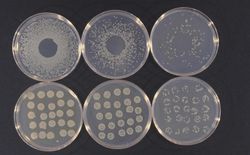Pseudomonas syringae
| Literature database |
|---|
| 1469 articles sorted by: |
| • year (descending) |
| • research topics |
| • countries/regions |
| • host plants |
| • list of antagonists |
Author(s): Chris Smart, NYSAES, Geneva NY
Source: Wikimedia Commons

Author: Howard F. Schwartz, Colorado State University
Source: Wikimedia Commons
Pseudomonas syringae van Hall
The pathogen is a Gram-negative and rod-shaped bacterium with an aerobic metabolism, and with polar flagella. It causes a wide range of plant diseases including blights, leaf spots, and galls. In general, it favors cool and moist conditions with temperatures between 12°C and 25°C. The species includes more than 50 different pathovars which are adapted to infect only a single or very small group of crops or wild plants. Traditionally, a pathovar was delimited by its host plants and disease symptoms. Today, a genetic multilocus sequence typing approach has been found to be a reliable method in allocating an unknown isolate to one of these pathovars.
The bacterium is characterized by its inability to properly utilize arginine. It enters the plant host with the help of cell wall degrading enzymes and with toxins which disrupt the natural defense system of the plant. Wounds and pruning facilitate infections. The pathogen persist in the environment as epiphyte, as latent infection, in healthy buds, or on alternate weedy hosts. It seems to survive poorly in the soil. Dispersal occurs through wind and rain, through infected plants or mechanically through insects or agricultural tools.
Apart from pathogenic strains, there are also saprophytic strains, including those which are antagonistic against bacterial and fungal plant diseases (see Pseudomonas syringae (antagonist)), as well as strains which are beneficial weed pathogens (see Pseudomonas syringae (weed pathogen)). Still other strains are beneficial to agriculture because of their capability to prevent/ reduce the effects of frost damage on crops.
For a review see Lamichhane et al., 2015
Currently, the following pathovars have been entered into the system:
- Pseudomonas syringae pv. actinidiae
- Pseudomonas syringae pv. aesculi
- Pseudomonas syringae pv. aptata
- Pseudomonas syringae pv. avellanae
- Pseudomonas syringae pv. coriandricola
- Pseudomonas syringae pv. garcae
- Pseudomonas syringae pv. glycinea
- Pseudomonas syringae pv. lachrymans
- Pseudomonas syringae pv. maculicola
- Pseudomonas syringae pv. mori
- Pseudomonas syringae pv. morsprunorum
- Pseudomonas syringae pv. papulans
- Pseudomonas syringae pv. persicae
- Pseudomonas syringae pv. phaseolicola
- Pseudomonas syringae pv. pisi
- Pseudomonas syringae pv. syringae
- Pseudomonas syringae pv. tabaci
- Pseudomonas syringae pv. tomato